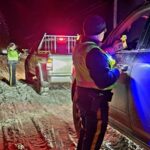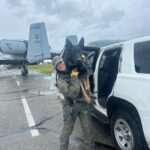Johnson's Landing recovery manager discusses the job and the long road ahead
Deb Borsos has a big job ahead of her.
The Argenta resident is the first person the Regional District of Central Kootenay has ever hired to be a recovery manager after a disaster.
She is the lead person in the recovery efforts for the Johnson’s Landing mudslide that happened on Thursday, July 12. The disaster killed four people and wiped out three houses.
“I was asked,” said Borsos of how she became the recovery manager.
“I had to think about it for a few days and I realized this could be an invaluable experience.”
While she’s new to the job, she isn’t new to emergency services. Borsos has spent the past two years as a volunteer on the emergency planning committee for Area D.
Professionally Borsos has worked for more than 20 years in hospital administration. Her knowledge of how to move information forward has been invaluable to her new post.
Her organization, her dedication and her great sense of humour seems to get her through a very tough and often stressful job helping the community of 35 people get back up.
The biggest challenge for her is “the hours in the day I have” not being enough.
The position could last anywhere between four and six months depending on where things go, said Borsos.
“From my perspective, my responsibility is to keep the community informed of what the other agencies are doing, helping liaison with those agencies and to communicate the desires of the community instead of the agencies just doing what they think is best,” said Borsos.
Since she took on this monumental task, Borsos has established a three-person advisory group to help her help them with getting what the community needs. She also keeps everyone informed by email so even the absentee landowners can keep in the loop.
“The absolute bottom line is to remain transparent and keep everyone in the loop as much as possible,” she said of her strategy.
Her biggest concern is getting the water system back up.
“In the long term I hope the community is on track and have moved forward with repairing and stabilizing the water system,” said Borsos.
“People are still adjusting to this enormous thing that has happened,” said Borsos. “We’ve now shifted from a hurry, hurry situation to recovery and dealing with everyday life. I can’t imagine how it is for them.”
Recovery manager is part of the emergency response process
Hiring a recovery manager from within or close to a community undergoing a massive emergency like the Johnson’s Landing slide is part of the provincial emergency plan and is now often recommended by Emergency Management BC.
The person is responsible for helping liaison between the government services and the community to ensure the community’s needs and wishes are met.
This is the first time the RDCK has hired one and so far they are pleased with the results, said Noreen Clayton, RDCK emergency coordinator.
“Having an emergency is like having an injury and recover is part of that,” said Clayton. “The injury took two minutes but the recovery takes much longer.”
In 2011 Clayton was involved in the recovery of the Kerr apartment fire in Nelson. During that disaster, a committee of community organizations like the Red Cross and the Salvation Army met once a week, then every two weeks for about six months to aid the recovery efforts and keep the communications going.
“The Kerr fire finished (recovery) in five months, which is pretty amazing,” said Clayton.
But in Johnsons Landing the geographical location limits how often all the assisting groups can meet, so assigning a single local person to the liaison job seemed to be the most obvious choice.
“So we thought we really needed someone from that community to help,” said Clayton.
The RDCK really lucked out with Borsos. She already had all the community contacts in place, had been involved in emergency planning and was even involved in a wildfire emergency that occurred in 2007 in her community.
“It is nice to have someone from the community, it is very helpful,” said Clayton. “Knowing the pulse of the community is helpful and recovery is what people want … This is their community and it is important they are included in all the decisions.”
Recovery could be speedier with manger in place
Clayton hopes that by having a recovery manager in place, the recovery process will be that much faster than if done without one.
In the case of the Kerr apartment fire, by having a community committee the recovery process took less time than without one, said Clayton.
“I think we’ll have a speedy recovery with this kind of model in place,” said Clayton.
When asked what kind of timeline she expected for the Johnson’s Landing recovery, she said it is hard to say right now.
“We’re just past the one month of the slide and a lot of unknowns and a lot of stuff to still figure out.”
“I hope we have resolved any water issues they have and have a permanent and reliable water system in place,” said Borsos. “I wish only the best for them and I hope they can get past this. They will be a different community but they will still be a community — they are resilient and resourceful.”
Clayton said the biggest thing is to get people who have been displaced by the slide — 12 properties continue to be on the evacuation list — places to live and a way to continue on with their lives.
Unlike the Alberta community of Slave Lake, which was devastated by wildfires in 2011, people may not be able to rebuild their homes, said Clayton. The slide is a permanent mark on the landscape.
This disaster had created some “extraordinary expenses” said Clayton. Unlike some disasters, this one requires a lot of extra people including 24-hour security and spotters to help every worker on site.
Fortunately the government will reimburse the RDCK for many of those expenses, said Clayton.
Earlier this month a team of geotechnical experts surveyed the slide to determine the potential danger of each region of the slide. Some residents may then be able to return to their homes to remove their belongings.
For those wishing to help those affected by the disaster, the Red Cross is accepting donations. For more information contact the Canadian Red Cross at www.redcross.ca or call 1-800-418-1111.


























Comments